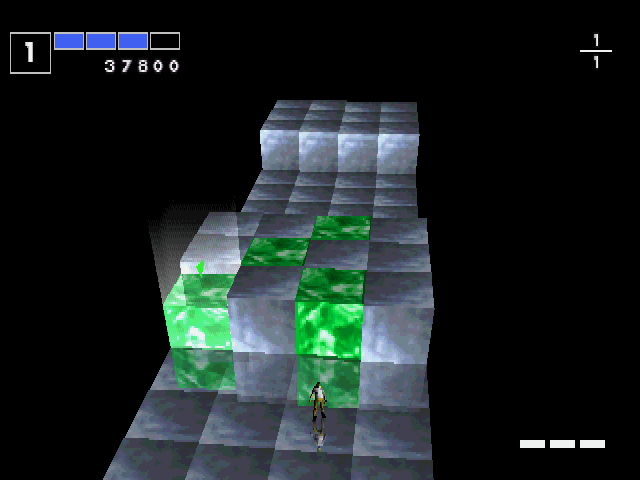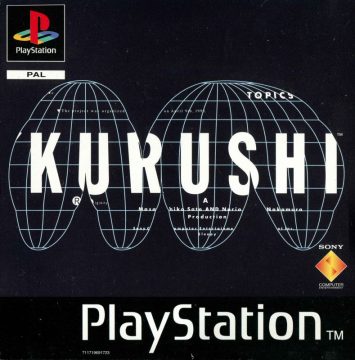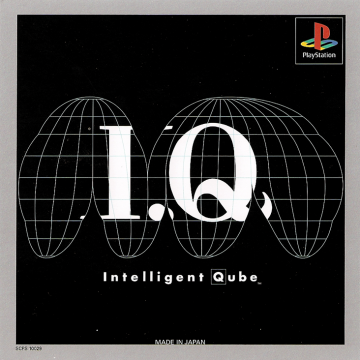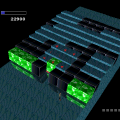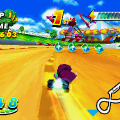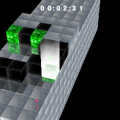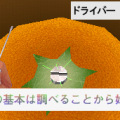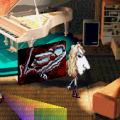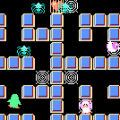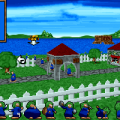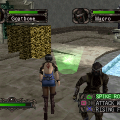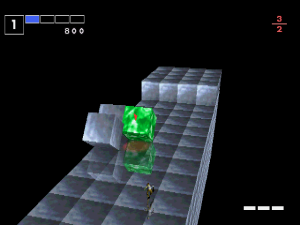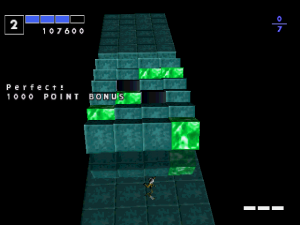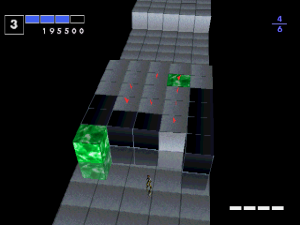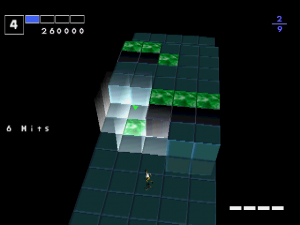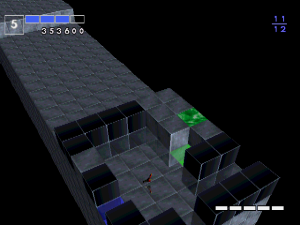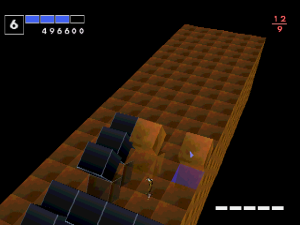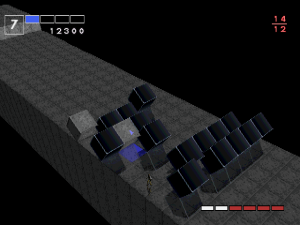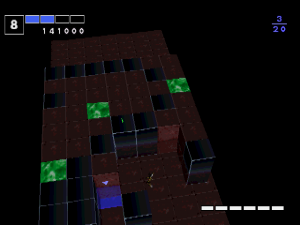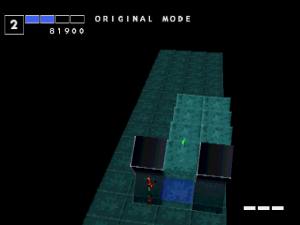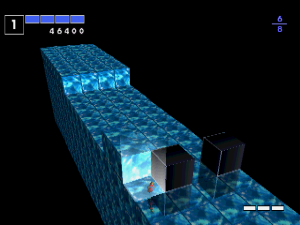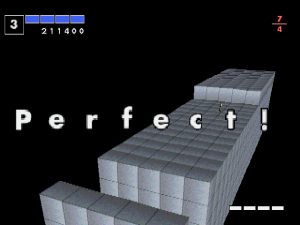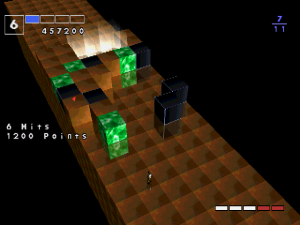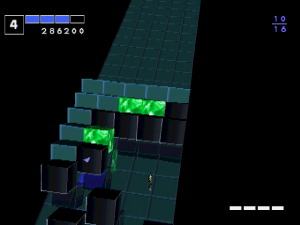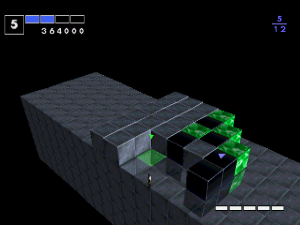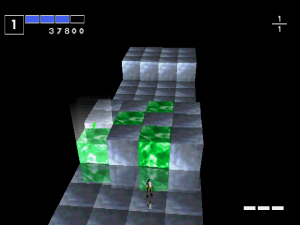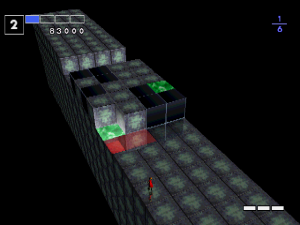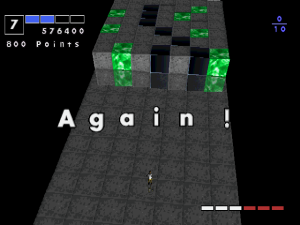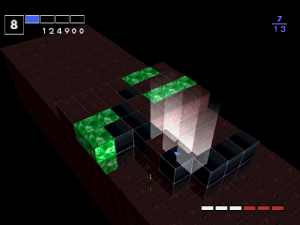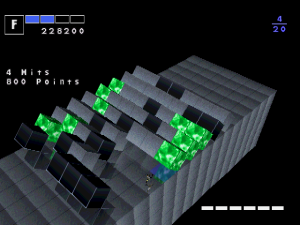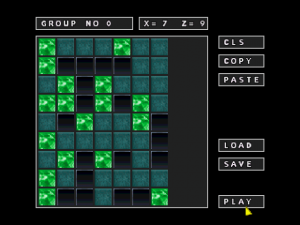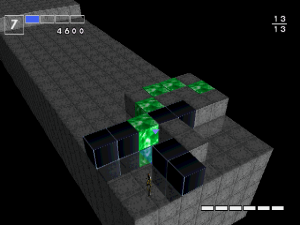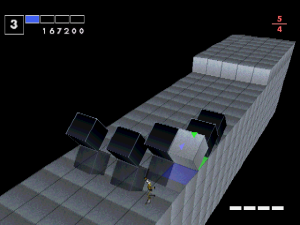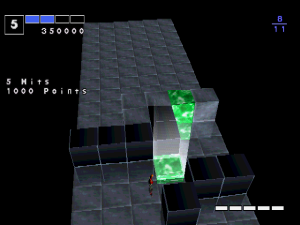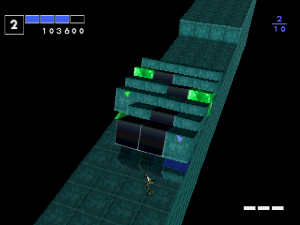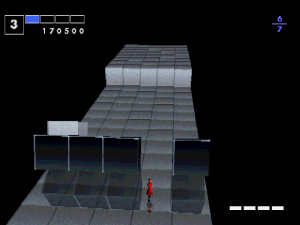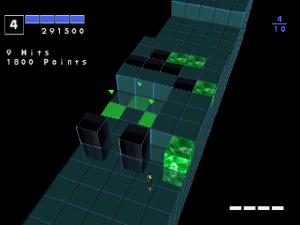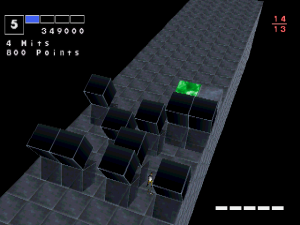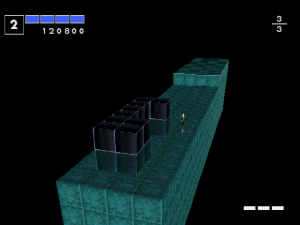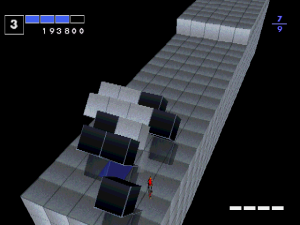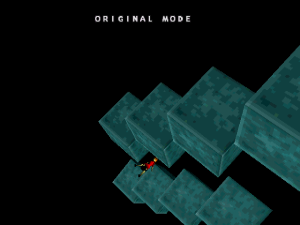- Intelligent Qube
- I.Q Final / Kurushi Final
- I.Q Remix+
- I.Q Mania
Puzzle games normally tend to be bright and cheery affairs, presenting their abstract gameplay with vivid colours and upbeat music to make the act of puzzle solving an openly welcoming and exciting time. That’s certainly not the case when it comes to Intelligent Qube, a PlayStation-era puzzler conceptualized by Masahiko Sato (a professor at the Tokyo University of Arts with a background in advertising).
Right from the start, the game establishes its tone by placing you, a little man, onto an empty platform suspended in an endless black void. Your footsteps echo as you move around with seemingly nothing to do, and then a group of cubes rise up from the ground. They march towards you, their towering height making it clear that they will squash you if you’re unlucky enough to get in their way.
All you can do is try not to be squished, and the only way to do that is to capture the cubes. You can mark the ground, which sets a trap highlighted by a blue square and a little arrow, and that will capture any cube which rolls onto it once activated. Your goal is to capture as many cubes as possible before they roll off the platform into the abyss, giving you a limited amount of time to do so.
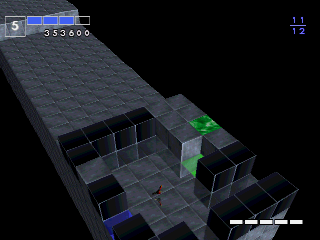
You have three types of cubes. Along with the standard kind, you can capture green advantage cubes which will leave behind a unique kind of trap. Signalled with a green square, these can be triggered at any time and will capture any cube in a 3×3 radius (or 3×2 if they’re at the edge of either side). Keep in mind that multiple advantage traps can be left behind, so activating one will set them all off.
This sounds like a great way of clearing out all the cubes, but it will lead to your downfall if you ignore the third and final cube type – forbidden cubes. Coated in pure black, capturing even just one of these cubes will cause a drone to call out, signalling the partial collapse of the platform you’re playing on. See, the platform is made of cubes, and capturing a forbidden cube causes one row to fall away. Letting a certain number of standard cubes to escape your grasp will also result in a lost row, but capturing forbidden cubes is the quickest way to oblivion.
Thankfully, all is not against you, for capturing all the cubes in a given group will reward you with an added row (heralded by an unseen voice crying out “PERFECT”). This still requires good on-the-fly planning and reflexes, as the cubes continuously thunder towards the edge and will only pause if you capture a cube. You can use the standard and advantage traps at different times, and even speed up the cubes’ movement if you want to execute your plans quickly.
If you’re able to last four rounds (each one consisting of roughly two or three groups of cubes), you’ll move onto the next stage. However, the stages continually introduce wider groups of cubes and increasingly trickier puzzles to deal with. It’s a lot to try and juggle cube positions, the nature of advantage cubes and forbidden cubes, and how much space you have left while the cubes carry on in their death march. Eventually, things might become too much and as the rows continue to collapse, you’ll simply end up falling off the platform into the abyss.
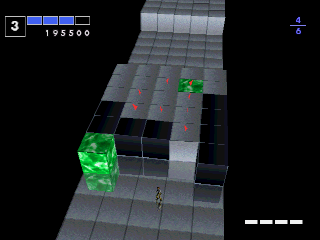
At the very least, you’re able to continue from the beginning of the stage as many times as you like, though your score will reset to 0 and subsequently the IQ (or Intelligence Quotient) gauged from whatever points you earn will be significantly smaller compared to a run done from the very beginning. Points are mainly earned by capturing cubes efficiently, particularly if you can grab them under a certain amount of moves as shown from an onscreen counter which starts ticking as soon as you’ve captured your first cube.
Getting points isn’t hugely important, though it works to show your ability at not just solving the many puzzles but being able to endure for as long as you possibly can, perhaps even reaching the end. Every session has you starting from the beginning, and each stage lasts a good few minutes, so it’s a real commitment to survive for that long. That said, you can increase the game speed to clear stages more quickly, though with less time to plan things out.
There’s such an unsettling mood to Intelligent Qube, starting with the nightmarish scenario of trying to deal with marching cubes in a black void and extending outwards to the rest of the presentation. The stark artstyle and minimalist UI create an eerie mood, while never getting in the way of your ability to solve puzzles (and with a smooth 60fps framerate on top of that). This is complimented by the excellent sound design; the echoing of your footsteps, the thundering thud of the cubes, the drones that accompany the opening/ending of stages and the dreaded capturing of forbidden cubes, the stern voice denoting your progress. Each sound is delivered with a cold, detached intensity that gives every move an enormous weight.
What ties everything together is the soundtrack by Takayuki Hattori, an anime and game composer who had recently worked on projects such as Romance of the Three Kingdoms V, Martin Successor Nadesico and the Slayers films & OVAs. Utilizing an orchestra and choir, the music imbues the game with a heavily oppressive atmosphere, where you’re scrambling to survive as dissonant melodies and wordless voices shout at you from beyond. The further you progress, the more haunting the music becomes, and it even changes to a frantic “crisis” piece if you lose enough rows that a game over is almost certain. It’s an amazingly apocalyptic score that helps to push Intelligent Qube from a neat puzzle game to a superbly ominous experience.
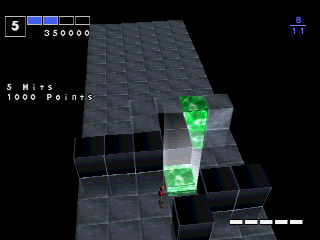
Completing the game unlocks a second character to play as named Cynthia, along with a secret mode titled Original mode, in which you can create your own puzzles for the game to throw in. You can save these puzzles to the memory card and play through this mode, though these puzzles aren’t guaranteed to appear and the game doesn’t keep a move counter. A third character can also be unlocked if you beat the main game with an especially high IQ. There’s a limited two-player mode where you and another player take turns solving puzzles, and whoever gets the best of 10 wins.
Masahiko Sato was involved in the creation of the next two Intelligent Qube titles, and he would continue to make cube-based puzzlers elsewhere with the help of Masasuke Yasumoto and Masaya Ishikawa. These include Influence, released on the PSP as one of the PlayStation minis, and the iPhone-based game Pavlov.
Links:
A translated interview with Masahiko Sato talking about the process of Intelligent Qube’s creation and designing puzzles for it: https://shmuplations.com/iq/
